The Scorpion is a rather conspicuous constellation. It is close to the center of the Milky Way and also on the plane of the ecliptic as one of the 12 zodiac signs. Due to its bright stars lined shears and the scorpion-typical curved sting this constellation is relatively easy to spot in the sky even for beginners.
Shape and position: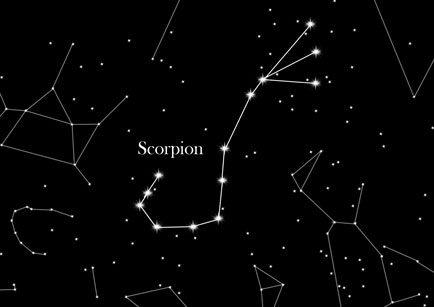
The brightest star of the scorpion was also called Qualbu’l-Agrab - “Heart of the Scorpion” by the Arabs due to its position. The Greeks had an interesting name for it as well: Antares (antares) – which means “Counter-Mars”. The name comes from the red colour of the star and the fact that Mars and “Counter-Mars” don’t meet each other often in the sky. Once you’ve found “Counter-Mars” you will be able to recognize the shears and the sting of the scorpion that is sticking up. Unfortunately you can only see this constellation during the summer and even then it’s incomplete because of the very southern sky position.
Right ascension: 15h 47m to 17h 59m
Declination: -46 to -8 degrees
Brightest star: Antares (Magnitude 1.06)
Mythology:
In order to make the king’s daughter, Merope, his wife, the experienced hunter Orion had to free the island of Chios from all wild animals according to mythology. He was unable to do so despite all his experience, so the king did not allow him to marry his daughter. Orion got very upset about this, and he wanted to kill all the animals in the world. This made Gaia, the Earth Goddess, very scared. She sent out a small, but dangerous scorpion to stop the extinction of all animals and Orion from causing any harm. The Goddess of the Hunt, Artemis, liked Orion and wanted to shield him from his ruin. She solved the conflict in a simple manner. She placed both of them on opposite ends of the firmament. Even today Orion and the Scorpion stay far away from each other in the sky – you will never see them at the same time.
Astrological significance: People born under the Zodiac sign Scorpio are strong-willed and self-confident. Being very passionate they can become jealous and vindictive. They are very honest and sincere and can help people with that, but hurt them as well. The Scorpion’s element is the water.
Best season for observation: Summer
Neighbouring constellations: Scales, Wolf, Norma, Altar, Southern Crown, Sagittarius
Buy a Star Blog
-
Star Sign Scorpion
-
Star Sign Lizard
The Lizard is a nondescript and small constellation. It contains only a single star, no brighter than magnitude 4. The Lizard does not belong to the classical constellations of antiquity, as it was not discovered until much later.
Shape and position: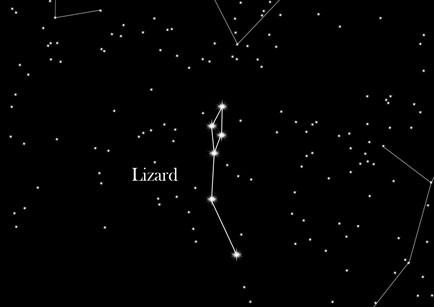
The Lizard is pretty unimpressive in the sky and bordered to the north Cepheus, Swan on its left, and in the south is the constellation Pegasus. In East are Andromeda and Cassiopeia.
Right ascension: 21h 57m to 22h 57m
Declination: +35 to +56 degrees
Brightest star: Alpha Lacertae
Mythology:
The constellation Lizard does not belong to the classical constellations of the ancient world. Nevertheless, there are some equally interesting stories about the Lizard, as in the classical zodiac in the form myths. This constellation was introduced in 1687 by Johannes Hevelius, a Danzig Astronomers. Its name was originally different, but it was not politically accepted at the time, and so, it was renamed to the „Lizard“.
Best season for observation: Autumn
Neighbouring constellations: Andromeda, Cassiopeia, Swan, Cepheus, Pegasus -
Star Sign Cepheus
The constellation Cepheus is a less flashy constellation next to Cassiopeia and the Dragon. Cepheus is a constellation from the collection of Ptolemy and one of the oldest constellations. Because the Cepheus can be observed throughout the year this is one of the so-called "circumpolar constellations".
Shape and position: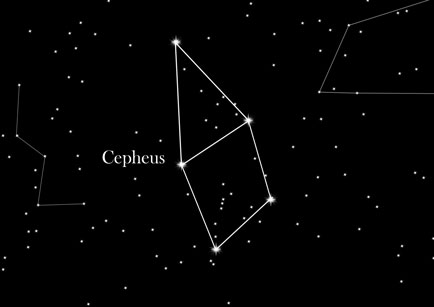
Cepheus is located near the north celestial pole and has no star that is brighter than magnitude 2 - that makes it look distinctly unimpressive as its neighbors (Cassiopeia and Dragon) has much brighter stars than Cepheus. The southern part of Cepheus is an offshoot of our Milky Way. Very nice to watch, its many variable stars and double stars, for example, the famous Delta Cephei.
Right ascension: 20h 9h 1m to 3m
Declination: 53 to 88 degrees
Brightest star: Alpha Cephei (Alderamin)
Mythology:
According to the Greek mythology, Cassiopeia, the wife of King Cepheus, believed she was more beautiful that the daugters of the sea god Nereus. Therefore, the daugters demanded the punishment of Cassiopeia. Posseidon, another sea god, therefore sent a sea monster for her. She was however saved by Perseus in the end, and to this day, they still both have a place in the sky.
Best season for observation: All year round
Neighbouring constellations: Swan, Lizard, Cassiopeia, Giraffe, Dragon, Little Bear -
Star Sign Scales
Libra, or 'The Scales', is not the best defined constellation in the sky, despite containing a binary star system. Libra is a constellation which can be observed in the Northern hemisphere from January until July. Although it consists of faint stars, its brightest star is Zuben el-Schamali (the 'northern claw'). Inexperienced star gazers may find it difficult to work out the shape of The Scale and it often requires a lot of imagination to picture the constellation's shape. The sun appears in the constellation from October 31 until November 23, and Libra is well-known as a sign of the Zodiac.
Shape and position: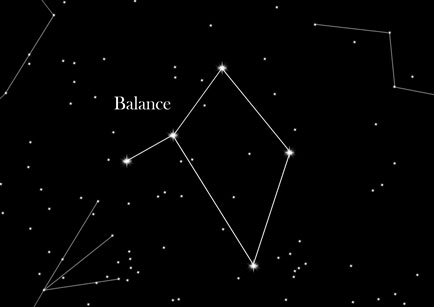
Libra is located between the constellations of Virgo to the east and Scorpio to the west. Zuben el-Schamali is the constellation's most easily visible star, forming the basis for the 'balance' component of The Scale. This star is a blue dwarf, and is located exactly on the apparent ecliptic of the sky. A notable feature of Libra is its 'Bar Star', or Alpha Librae, which is actually a binary star system. This phenomenon can be observed relatively straightforwardly from Earth using binoculars.
Right ascension: 14h 21m to 16h 02m
Declination: -30 to 0°
Brightest star: Beta Librae (Zuben el-Schemali)
Mythology:
The ancient Sumerians knew the constellation as the Scale, though the origin for this name is unclear. Some suspect the name may relate to the Autumnal Equinox, which at the time was when the sun passed through the constellation and the length of day and night was 'balanced' equally. It could also be derived from the shape of beam balances used by tax collectors at that time. Both the Babylonians and the Greeks referred to the constellation as the 'Claws of the Scorpion'. The Romans later identified Libra as the scales of justice held by the goddess Astraea.
Astrological significance: People born under this sign of the Zodiac are usually considered open-minded and intelligent. They often pursue a variety of projects with enthusiasm, but can appear a little unbalanced. Their diplomacy and willingness to help others often mean that they are widely regarded with affection. Libra's element is the Air.
Best season for observation:: Spring
Neighbouring constellations: Virgin, Ophiuchus, Scorpion, Wolf -
Star Sign Little Horse
The constellation "Little Horse" is also known as the "Foal", and consists only of four visible stars which does not impress much. The shape of the constellation is like that of a little horse, and only one of its stars is brigter than size 4.
Shape and position: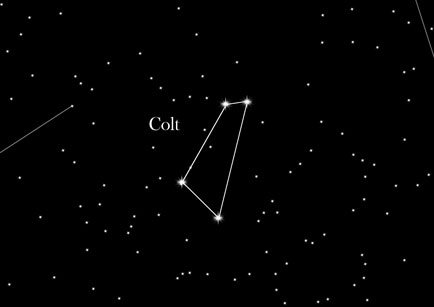
The constellation "Little Horse" is one of the smallest constellations in the sky, the only one smaller is the Southern Cross. Next to this constellation you find the constellation Pegasus.
Right ascension: 20h 56m to 21h 26m
Declination: +2 to +13 degrees
Brightest star: Alpha Equulei (Kitalpha)
Mythology:
In Greek mythology, one myth associates Equuleus with the foal Celeris (meaning "swiftness" or "speed"), who was the offspring or brother of the winged horse Pegasus. Celeris was given to Castor by Mercury. Other myths say that Equuleus is the horse struck from Poseidon's trident, during the contest between him and Athena when deciding which would be the superior. Because this section of stars rises before Pegasus, it is often called Equus Primus, or the First Horse.
Best season for observation: Autumn
Neighbouring constellations: Pegasus, Dolphin, Aquarius


